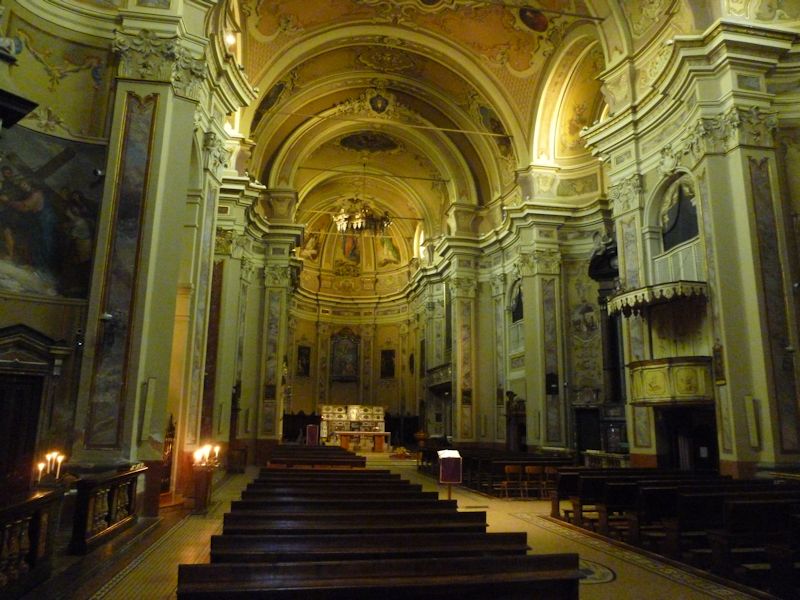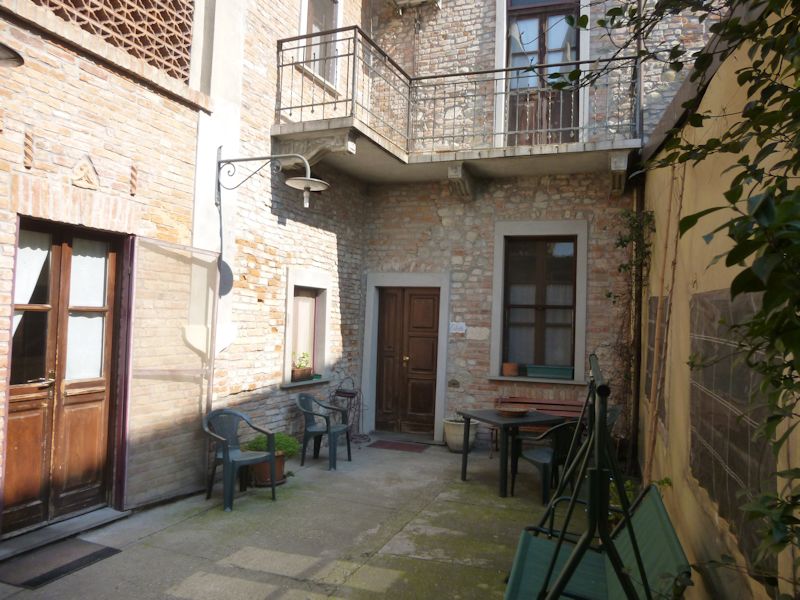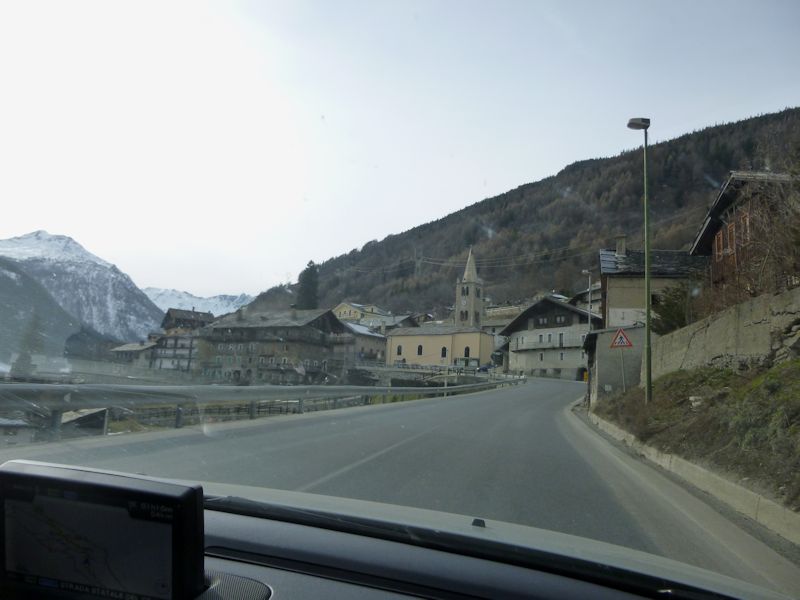|
 Dwight Peck's personal website Dwight Peck's personal website
Tuscany in the off-season
Arezzo and the neighborhood in February and early March, 2015
You may not find this terribly rewarding unless you're included here, so this is a good time for casual and random browsers to turn back before they get too caught up in the sweep and majesty of the proceedings and can't let go.
Our sojourn in Arezzo and thereabouts is sadly at an end, we're headed home, but stopping off in Cremona for a few days on the way.
Cremona, and a revictualing stop in Lu

After some highly entertaining dawdling around the neighborhood, trying not to look like a tourist, we return to the Chiesa di San Michele, punctually, and await the monk with the key, less punctual.

We hope that lunch in the refectory was healthy and fun. The present Romanesque building was begun in the 1200s and modified somewhat since, but there are Lombard remains in the crypt from an earlier medieval period.

It's a very attractive interior, perhaps the oldest in the city. Fifteenth century chapels line the aisles.

A triptych of the nativity by Bernardino Campi, with Saints Leonardo and Theodora, 16th century

St Michael whacking the Beast

The high altar

Chapels along the aisles


Just down the street, here's the Holy House of Loreto in San Abbondio . . .

. . . with its cute terra cotta Madonna/Bambino set.

We need to be respectfully discreet here, because there are three Filipino nuns and some stragglers listening to a lengthy sermon.

'The economy is not IN crisis; the economy IS the crisis'

The Civic Museum of Cremona, with Cremona's mascot for the 2015 Expo Milan: "Foody". (As I write, two months later, the opening of the Expo Milan has been met with preplanned rioting in the streets.)

The afternoon passeggiata, everyone out to see and be seen

Nobody's in a hurry, and that's healthful, good, and kind of charming; but I need to find the beer and wine store.

This, semi-humorously, is the Palazzo Cittanova, built in 1265 by the Guelph or 'popular' faction in the city opposed to the Ghibelline faction of 'notables' downtown around the Duomo. For some time, it housed the meetings of the Council of the New City, until in 1412 it became the headquarters of the merchants of textiles, then a barracks, then archives. Presently it's a conference centre.

Across Garibaldi Street from the Palazzo Cittanova is the Church of Sant'Agata, originally part of an Augustinian monastery. First built in 1077 it was rebuilt in the 12th century, but most of this neoclassical façade and interior dates from the first half of the 19th century.

So there it is.

That's sort of nice, though, whatever it is. Scenes from the life of Saint Agatha.

The three aisle nave of Sant'Agata

The church of Sant'Ilario, reconstructed from a 12th century original in 1716-1766, but never finished.

The 18th century interior

The passeggiata

The Coast to Coast Express in the Pope John Paul II Gardens

We collect photos of tourist 'road-trains' in European cities: here.

Piazza del Comune

The Torrazzo

Stradivari and friend from another angle

The next day, 9 March, this is the Simply Market. I've spent the morning strolling about, taking a wrong turn early on, however, and ending up far out in the countryside without a map for getting back with. This signifies some kind of civilization, and can the city be far off from here? (The Simply Market is actually a new French chain intended to replace the Atac brand markets.)

The Park of the Fallen of Nassirya. The Italians, for political reasons that can only be guessed at, joined the "U.S.-led coalition" in the invasion of Iraq, and 19 Italian soldiers were killed by a truck bomb attack on the Italian military police HQ. It was the highest loss of Italian soldiers since World War II, and the population was not at all happy about their politicians' ill-conceived commitments in their name.

The church of San Luca, 15th century -- supposed to be not too far from the rail station.

The rail station of Cremona (I'm back into knowable territory) -- a railway hub with links to Pavia, Mantova, Milan, Parma, Brescia, and Piacenza, and . . .

. . . its own Garibaldi statue.

Halal Fried Chicken (with a sort-of American flag in the lunette)

Back past the Church of Sant'Agata on the Via Garibaldi, heading into town now

Late afternoon drinks in the Piazza Stradivari

That, however, is not Stradivari. In fact, it's Claudio Monteverdi. What other interesting people may have come from Cremona? Amongst many others, there's Publius Quinctilius Varus, who led three Roman legions into the German Teutoberg Forest in AD 9, called Rome's Greatest Defeat (Adrian Murdoch, History Press, 2008); Marozia, the pornocratic 10th century 'mother' of seven Popes; Sofonisba Anguissola, the worthy female painter who led the way for Artemisia Gentileschi and Lavinia Fontana; and Chiara Ferragni, the "Blonde Salad", a blogging fashion designer.

Forthright expressions of opinion

A kiosk showcasing Nightwish's newest album, fronting Floor Jansen
(first impression: it doesn't measure up to the rest of the Nightwish canon)

-- Goodbye. Come back to Cremona someday.
Lu

Kristin's feeling all well again, perhaps thanks to restorative lunches provided by the Hotel Duomo at no charge. We're off home, 10 March 2015, with a mandatory diversion to Lu (between Alessandria and Casale Monferrato) for more Grignolino in bulk.

Uptown Lu, near the Palazzo Paleologi (not shown), where we stayed the last time we were here

The Cantina Sociale is closed for lunch, but luckily the Ristorante La Trinità is not.

The Ristorante Trinità in Lu, an excellent inexpensive lunch and friendly local ambience

Lunchtime is over, we're on the move

The Cantina Sociale of Lu, a wine cooperative founded in 1906, now with 32 associates, was the first of what became a popular movement in the region.

The Grignolino and Barbera from the Casale Monferrato region hereabouts are rated as the best of those to be found anywhere, and here the prices are very low indeed, even factoring in the small customs tax on each bottle at the Swiss frontier
(we always declare).

What a place for a party. Each celebrant with his or her own vat.


The car is loaded up, the back of the car is only half an inch off the ground, and we start for home.

The flat floodplain of the Po west of Casale Monferrato

The first sign of the mountains

Up into the Valdaosta, or Aosta Valley

Fort Bard on a gorge of the Dora Baltea river; fortifications here monitored trade and travelers down the Aosta Valley since the time of Theodoric in the 5th century and a later 10th century castle -- in 1800, 400 Austrians and locals held up Napoleon's 40,000-strong invasion army for two weeks here -- but the present structures were built by the Savoy dynasty in the 1830s. The establishment, long neglected, was renovated and reopened in 2006 as the 'Museum of the Alps' and hosts exhibitions, art galleries, and cultural performances. (We went back to check it out more thoroughly some months later.)

A small hilltop castle, higher in the mountains

And another

Above Aosta, we're approaching the Grand St Bernard Pass, or rather, at this season, the tunnel under the top parts of the Pass.

Above the highest towns

And shortly to pay our customs tax at the frontier in the GSB tunnel and be back in Switzerland, after a very good trip.
        
      

 Feedback
and suggestions are welcome if positive, resented if negative, Feedback
and suggestions are welcome if positive, resented if negative,  .
All rights reserved, all wrongs avenged. Posted 11 May 2015. .
All rights reserved, all wrongs avenged. Posted 11 May 2015.
|
 Dwight Peck's personal website
Dwight Peck's personal website









































































